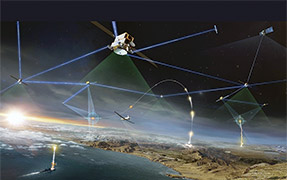Direct writing of waveguides and other microstructures in dielectrics
Attempts to fulfill the promise of low-cost, mass-produced, planar lightwave circuits (PLCs) for the photonics industry has been plagued by the complex processes required for their production. Once a circuit has been designed, creating the final device requires multiple steps including fabrication of the mask, production of the planar buried-layer substrate, coating with a photo-resist, mask exposure, and a multi-stage chemical-handling process.1
Most of these steps are performed in an expensive clean-room environment. Even fabrication of simple, high-quality grooves for bio-medical applications has followed a similar, high-technology route. The steps to make waveguides in planar silica can take several days, if not weeks. Since each step has its own yield challenges, reducing the number of steps has a big impact on the final cost.
Researchers have used a number of techniques to tackle this issue. Perhaps the most promising has been the direct laser writing of waveguides into planar films of photosensitive germanium-doped silica on a silicon platform.2 Exposure of this material to a focused UV laser beam increases the local refractive index, forming a waveguide. However, this technique requires a photosensitive material, as well as an additional annealing step to stabilize the waveguide. Recently, the femtosecond laser has emerged as a candidate for a direct-write laser scheme, although ways of scaling the process to larger throughput is difficult to foresee. There are several positive attributes of these two methods, but although high-quality waveguides are possible at relatively slow speed with direct UV writing, these have yet to be demonstrated with the femtosecond laser system.
A direct laser writing system that allows the easy fabrication of waveguides and also permits the sculpturing of materials in one step has remained a dream, until now. We have recently developed3 and patented a flexible and relatively inexpensive method that eliminates most of the steps required to fabricate low-loss PLC circuits by using a carbon-dioxide laser to remove material by ablation. Excavating two adjacent channels simply sandwiches a ridge waveguide in between, and eliminates all other process steps in planar silica waveguide fabrication.
These waveguides have similar losses, less than 1dB/cm, to those made with standard PLC or UV-laser-writing techniques. Additionally, the processing time for making waveguides is only a few seconds, making the technique ideal for turn-key production. A typical single-mode near-field pattern at 1.5μm is shown in Figure 1(a). In Figure 1(b) is a serpentine pattern generated for a lab-on-a-chip demonstration by the same processing technique, fabricated in a matter of seconds. Figure 1(c) shows the flexibility of the system to produce complex micro-fluidic channels. We have also made low-loss 3dB waveguide splitters.

The remaining steps of cutting, polishing, pig-tailing and packaging still have to be performed, as they do with all other planar waveguides. However, the simplicity of our technique reduces the production time for waveguides to less than one day from the design stage to the final device.
We are currently working on a series of complex devices to rigorously prove the technology and evaluate the production economics. We believe that our method will significantly impact the production and cost of planar waveguides, micro-fluidics, and sensors, as well as lab-on-a-chip devices.
Support from the Natural Sciences and Engineering Research Council of Canada's Ideas to Innovation programs, the Canada Research Chairs program, Univalor, and PhotoNova Inc. is acknowledged.
Raman Kashyap holds the Canada Research Chair on Future Photonic Systems and is a professor jointly in the Departments of Electrical Engineering and Engineering Physics at the University of Montreal in Canada. He was previously head of Corvis Canada and was at British Telecom Research Labs, UK, for 25 years. He is the author of the first book on fiber Bragg gratings. He is also the president of PhotoNova Inc. In addition, he is a member of the Technical Program Committee and the chair of the Guided-Waves session of the Photonics North Conference, has presented several invited talks, and has authored or co-authored approximately 20 articles in SPIE proceedings.



